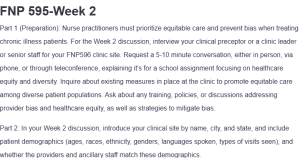FNP 595-Week 2
My clinical site is Inland Empire Primary Clinic in Upland, California, and is run by volunteer groups. The clinic served over four million patients in 2018, of which 13.1% were adults aged 65 and above. Spanish-speaking Latinos form the majority of populations served in the clinic, routine checkups, treatment of common illnesses, and referral services. The number of staff in Inland Empire Primary Clinic matches the demographics (California Health Care Foundation, 2020).
The interviewed person was Myra Nunez. She is a professional nurse and staff at the Inland Empire Primary Clinic. She noted that the primary role in the clinic is to work with medical students and other volunteer staff in providing healthcare services to the communities. She added that the clinic prides itself in delivering equitable healthcare services. Through its motto of care to all, the organization has rolled out several measures to ensure all populations served access to high-quality care. Some strategies utilized by the organization include providing free care services, promoting health through community outreach programs, and providing health education to all underserved communities. The strategies may be sufficient in addressing apparent inequities within the communities served. Ms. Nunez noted that the clinic has a non-discriminatory policy that guides all operationalizations within the clinic.
Health promotion and education to diverse communities are some of the strategies that can reduce health inequities. McGrail et al. (2022) note that the promotion of healthy behaviors across communities through health education and promotion can help reduce health disparities. Despite their effectiveness, health promotional activities may sometimes be suppressed by financial barriers as health promotional programs fetch significant financial considerations. Addressing these barriers through fund mobilization is thus key. The success of such programs can be measured by assessing the community’s knowledge of diverse health promotional activities and behaviors.
References
California Health Care Foundation. (2020, December). Inland empire: Increasing Medi-Cal coverage spurs safety-net growth. California Health Care Almanac. https://www.chcf.org/wp-content/uploads/2020/12/RegionalMarketAlmanac2020InlandEmpire.pdf
McGrail, K., Morgan, J., & Siddiqi, A. (2022). Looking back and moving forward: Addressing health inequities after COVID-19. The Lancet Regional Health – Americas, 9, 100232. https://doi.org/10.1016/j.lana.2022.100232
ORDER A PLAGIARISM-FREE PAPER HERE
We’ll write everything from scratch
Question
FNP 595-Week 2
Part 1 (Preparation): Nurse practitioners must prioritize equitable care and prevent bias when treating chronic illness patients. For the Week 2 discussion, interview your clinical preceptor or a clinic leader or senior staff for your FNP596 clinic site. Request a 5-10 minute conversation, either in person, via phone, or through teleconference, explaining it’s for a school assignment focusing on healthcare equity and diversity. Inquire about existing measures in place at the clinic to promote equitable care among diverse patient populations. Ask about any training, policies, or discussions addressing provider bias and healthcare equity, as well as strategies to mitigate bias.
Part 2: In your Week 2 discussion, introduce your clinical site by name, city, and state, and include patient demographics (ages, races, ethnicity, genders, languages spoken, types of visits seen), and whether the providers and ancillary staff match these demographics.
Summarize the interview findings and then propose specific actionable suggestions for your site, based on the current literature available. Identify potential barriers to implementation and outline how success could be measured. Include a reference list with a minimum of one high-level scholarly reference for competency, and for excellent or superior scores, two or more recent high-level scholarly sources in APA format.
Expectations

FNP 595-Week 2
Initial Post:
- Length: A minimum of 275 words, not including references
- Citations: At least one high-level scholarly reference in APA from within the last 5 years

